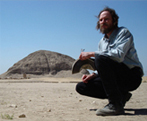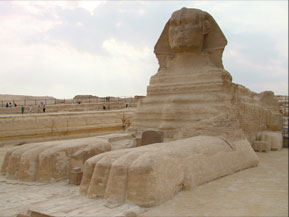
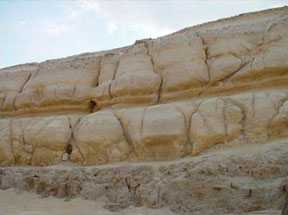
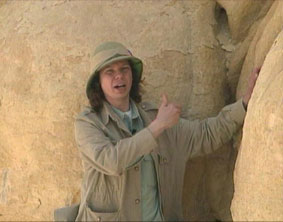

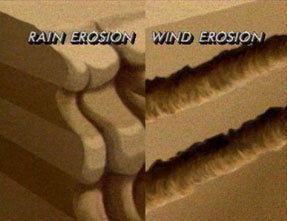
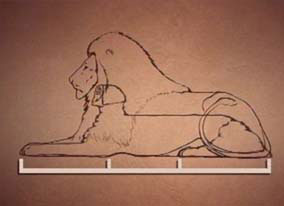
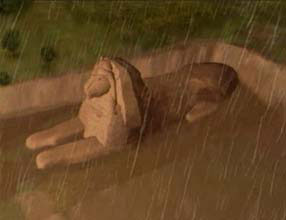
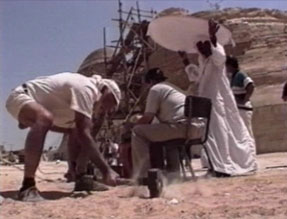
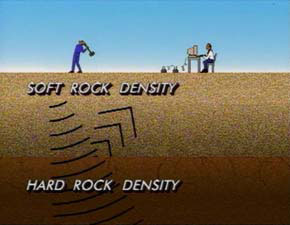
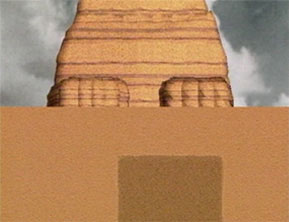
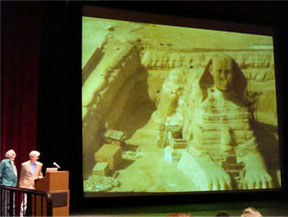
For those further interested, below is a link to an abstract of a technical paper I wrote, entitled "EROSION PROCESSES ON THE GREAT SPHINX AND ITS DATING." I presented the information at a 1999 conference organized by the University of Bergamo.
http://www.unibg.it/convegni /NEW_SCENARIOS/ Abstracts/Schoch.htm
For those still further interested, here are links to more information on the seismic data and the geological data.
Click below to download a PDF of an article I wrote for the Australian magazine New Dawn. It's titled, "Searching for the Dawn and Demise of Ancient Civilisation"
Many people know me best for my work on the Great Sphinx of Giza, Egypt. The Great Sphinx sits near the Great Pyramid on the western bank of the Nile, outside of modern Cairo. According to standard Egyptological thinking, the Great Sphinx was carved from the limestone bedrock on the orders of the Old Kingdom Pharaoh Khafre around 2500 B.C.
In 1990 I first traveled to Egypt, with the sole purpose of examining the Great Sphinx from a geological perspective. I assumed that the Egyptologists were correct in their dating, but soon I discovered that the geological evidence was not compatible with what the Egyptologists were saying. On the body of the Sphinx, and on the walls of the Sphinx Enclosure (the pit or hollow remaining after the Sphinx’s body was carved from the bedrock), I found heavy erosional features (seen in the accompanying photographs) that I concluded could only have been caused by rainfall and water runoff. The thing is, the Sphinx sits on the edge of the Sahara Desert and the region has been quite arid for the last 5000 years. Furthermore, various structures securely dated to the Old Kingdom show only erosion that was caused by wind and sand (very distinct from the water erosion). To make a long story short, I came to the conclusion that the oldest portions of the Great Sphinx, what I refer to as the core-body, must date back to an earlier period (at least 5000 B.C., and maybe as early as 7000 or 9000 B.C.), a time when the climate was very different and included more rain.
Many people have said to me that the Great Sphinx cannot be so old, in part because the head is clearly a dynastic Egyptian head and the dynastic period did not start until about 3000 B.C. In fact, if you look at the current Great Sphinx you may notice that the head is actually too small for the body. It is clear to me that the current head is not the original head. The original head would have become severely weathered and eroded. It was later re-carved, during dynastic times, and in the re-carving it naturally became smaller. Thus, the head of the Great Sphinx is not the original head. In fact, the Sphinx may not have originally been a sphinx at all. Perhaps it was a male lion.
To further test the theory of an older Sphinx, we carried out seismic studies around the base of the statue to measure the depth of subsurface weathering. Basically, we used a sledgehammer on a steel plate to generate sound waves that penetrated the rock, reflected, and returned to the surface. This gave us information about the subsurface qualities of the limestone bedrock. When I analyzed the data, I found that the extraordinary depth of subsurface weathering supported my conclusion that the core-body of the Sphinx must date back to 5000 B.C. or earlier.
During the seismic studies we also discovered clear evidence of a cavity or chamber under the left paw of the Sphinx. For what it is worth, some have suggested to me that this may be a "Hall of Records" (at the time I was not aware of Edgar Cayce's predictions along these lines). Additionally, we found some lesser (and previously known) cavities under and around the Sphinx, and the data also indicates that there may be a tunnel-like feature running the length of the body. A published article on our seismic work around the Sphinx is available via the link below.
Back in the early 1990s, when I first suggested that the Great Sphinx was much older than generally believed at the time, I was challenged by Egyptologists who asked, "Where is the evidence of that earlier civilization?" that could have built the Sphinx. They were sure that sophisticated culture, what we call civilization, did not exist prior to about 3000 or 4000 B.C. Now, however, there is clear evidence of high culture dating back over 10,000 years ago, at a site in Turkey known as Göbekli Tepe.
Was the Great Sphinx Surrounded By a Moat?
According to Robert Temple, a moat theory explains the water weathering of the Sphinx without hypothesizing that it dates back to an earlier period of more rainfall than the present. I will not address his other hypotheses, which I do not find persuasive, that the Sphinx was the jackal [wild dog] Anubis and the face seen on the Sphinx is that of the Middle Kingdom pharaoh Amenemhet II, though I note the original Sphinx has been reworked and the head re-carved.
While in Egypt recently (March 2009) I looked at the Great Sphinx with fresh eyes. I will summarize half a dozen points.
1) The Sphinx Temple (built out of blocks removed from the Sphinx Enclosure when the body of the Sphinx was initially carved) and the Valley Temple to the south show heavy precipitation-induced weathering on their core blocks. These limestone temples were subsequently refurbished with Aswan granite facings during the Old Kingdom. The moat theory cannot explain the nature of the very ancient weathering seen under the Old Kingdom granite veneer.
2) Much heavier surface erosion occurs on the western end of the Sphinx Enclosure, tapering off dramatically toward the eastern end. This is due to ancient rains and the paleohydrology of the area. This erosion is not compatible with pooled water in the enclosure.
3) The highest levels of the middle member strata, seen in the Sphinx Enclosure on the western end, are most severely eroded, as expected from rain. If the moat theory were true, then the lower strata on the eastern end of the Sphinx Enclosure would be most heavily eroded (caused by water being brought in via canals from the Nile), but the opposite is seen.
4) Seismic data demonstrating the depth of weathering below the floor of the Sphinx Enclosure, based on my analyses (calibrated very conservatively), gives a minimum age of at least 7,000 years ago for the core body of the Sphinx. Standing water in the Sphinx Enclosure would not accelerate the depth of weathering below the floor of the enclosure.
5) The vertical fissures observed in the walls of the Sphinx Enclosure show diagnostic signs of having been formed by precipitation and water runoff. They do not show any characteristics that are diagnostic or even suggestive of having been formed by artificial dredging of the Sphinx Enclosure, as Robert Temple suggests.
6) Assuming the argument that the Sphinx sat in a pool, either the water level around the Sphinx was the same as that of the surrounding water table, or the walls and floor of the pool were sealed up and watertight (and any artificial walls, such as on the eastern end, were strong enough to withstand the water pressure). (Note that the current western end of the Sphinx Enclosure is at a much higher elevation than the eastern end [see the figure on page 534 of The Sphinx Mystery by Robert Temple with Olivia Temple, Inner Traditions, 2009], yet clear water erosion is shown at the higher elevations at the western end. Since water seeks its own level, if the water in a supposed moat reached to the height of the western end of the Sphinx Enclosure, then the eastern end as well as the walls along the northern and southern sides must have been built up to a comparable height as the western end. This is independent of whether or not the eastern wall of the enclosure [= western wall of the Sphinx Temple] has a base of natural bedrock or was entirely composed of cut and placed stone.) We know that the ancient water table was well below the level of the floor of the Sphinx Enclosure (or else the Sphinx Temple would have been flooded). The Sphinx Enclosure, if simply carved from the bedrock (as all the evidence suggests) would not have held a deep pool of standing water. The bedrock in the enclosure is highly faulted, and characterized by a karst morphology that would leak like a sieve. The enclosure would need to be fully sealed up (with mortar or cement, perhaps), and there is no evidence of such sealing. If the enclosure had been sealed in such a manner, this would not be compatible with the dredging theory for the vertical fissures. Furthermore, chambers and tunnels under the Sphinx would have been flooded from above if the Sphinx had been sitting in a pool of water, unless the Sphinx Enclosure had been watertight.

